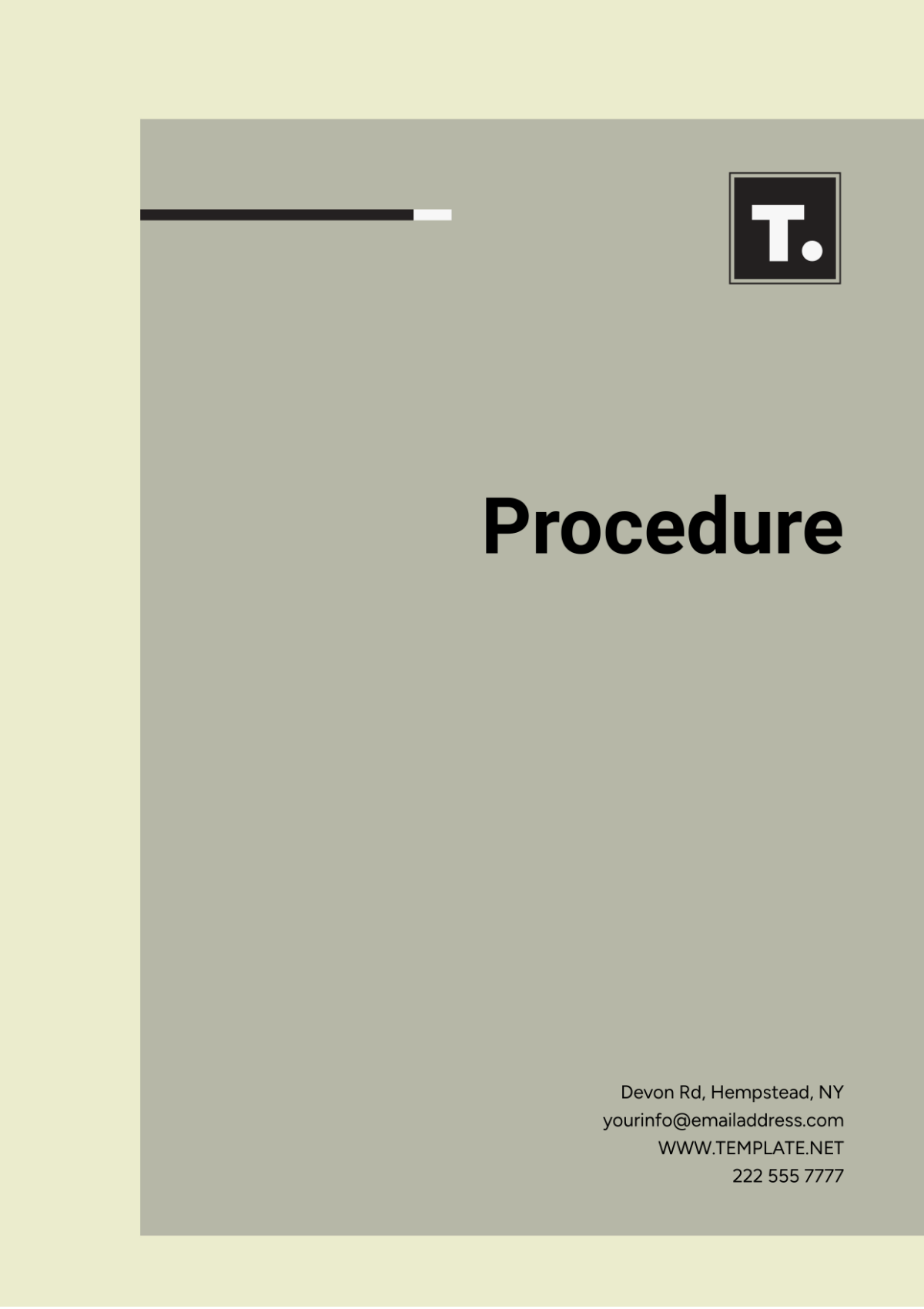Gym Finance Standard Operating Procedure
Introduction
Effective financial management is crucial for the sustainability and growth of any gym. A comprehensive standard operating procedure (SOP) for financial operations ensures consistency, accuracy, and accountability in all financial transactions. This document outlines the procedures for handling various financial tasks within [Your Company Name], including budgeting, revenue management, expense tracking, financial reporting, and internal controls.
Objective and Scope
Objective
The primary objective of the Gym Finance Standard Operating Procedure (SOP) is to establish a comprehensive and systematic approach to financial management within [Your Company Name]. This document aims to ensure accuracy, consistency, and accountability in all financial operations, thereby supporting the gym's overall strategic goals and enhancing financial performance. By adhering to these standardized procedures, [Your Company Name] aims to achieve the following objectives:
Financial Stability and Growth:
Ensure the gym's financial resources are managed effectively to support sustainable growth and long-term stability.
Optimize revenue streams and control expenses to maximize profitability.
Regulatory Compliance:
Maintain compliance with all relevant financial regulations and reporting requirements.
Ensure timely and accurate financial reporting to stakeholders, including regulatory authorities, investors, and management.
Operational Efficiency:
Streamline financial processes to improve efficiency and reduce administrative burdens.
Implement robust internal controls to safeguard assets and prevent fraud.
Transparency and Accountability:
Foster a culture of transparency and accountability in financial management.
Provide clear guidelines and responsibilities for staff involved in financial operations.
Enhanced Decision-Making:
Provide accurate and timely financial information to support informed decision-making by management.
Utilize financial analysis and reporting to identify trends, opportunities, and areas for improvement.
Risk Management:
Identify, assess, and mitigate financial risks that could impact the gym’s operations and financial stability.
Develop contingency plans and maintain adequate financial reserves to manage unforeseen events.
Scope
The scope of this SOP encompasses all financial activities and processes within [Your Company Name]. It applies to all employees involved in financial management, from senior management to finance department staff and operational managers. The SOP covers the following key areas:
Budgeting and Financial Planning:
Procedures for preparing, approving, and monitoring the annual budget.
Guidelines for revenue projections, expense forecasting, and capital expenditures.
Revenue Management:
Processes for managing and recording all income streams, including membership fees, personal training sessions, group classes, and merchandise sales.
Policies for billing, payment collection, and handling late payments.
Expense Management:
Procedures for authorizing, processing, and reporting operational expenses.
Guidelines for payroll management, including employee classification, tax withholding, and benefits administration.
Policies for capital expenditures and asset management.
Financial Reporting:
Processes for preparing monthly, quarterly, and annual financial statements.
Guidelines for conducting variance analysis and ensuring regulatory compliance in financial reporting.
Internal Controls:
Implementation of segregation of duties, access controls, and reconciliation procedures.
Guidelines for conducting internal and external audits to verify the accuracy of financial records.
Cash Management:
Procedures for managing cash receipts and disbursements.
Policies for cash flow forecasting and liquidity management.
Financial Policies and Procedures:
Detailed policies for expense reimbursement, procurement, and travel.
Guidelines for documenting and approving financial transactions.
Risk Management:
Processes for conducting regular risk assessments and impact analyses.
Strategies for mitigating identified financial risks and developing contingency plans.
Compliance and Reporting:
Ensuring adherence to all financial regulations and statutory requirements.
Timely and accurate reporting to regulatory bodies and stakeholders.
Implementation and Review
The effective implementation of this SOP requires commitment from all levels of the organization. Training will be provided to ensure that all relevant staff understand and adhere to the procedures outlined in this document. Regular reviews will be conducted to ensure the SOP remains current and effective in addressing the gym's financial management needs. Feedback from staff and management will be incorporated into periodic updates to this SOP, ensuring continuous improvement and alignment with best practices in financial management.
1. Budgeting and Financial Planning
Budgeting is the foundation of financial management, providing a roadmap for revenue generation and expense control. Proper budgeting helps in aligning financial resources with the gym's strategic goals.
1.1 Budget Preparation
The annual budget preparation process begins in November and involves input from all department heads. The process includes:
Revenue Projections: Estimate revenue based on membership trends, personal training sessions, group classes, and merchandise sales.
Expense Forecasting: Identify and forecast all operating expenses, including salaries, utilities, maintenance, and marketing.
Capital Expenditures: Plan for significant investments in equipment, facility upgrades, and technology.
Contingency Planning: Allocate funds for unforeseen expenses or emergencies.
1.2 Budget Approval
The proposed budget is reviewed and approved by the senior management team by December. The approved budget serves as the financial blueprint for the upcoming fiscal year.
1.3 Budget Monitoring
Monthly budget reviews are conducted to compare actual performance against the budget. Variances are analyzed, and necessary adjustments are made to ensure financial objectives are met.
2. Revenue Management
Revenue management involves tracking all income streams and ensuring timely collection. This section details procedures for managing membership fees, personal training sessions, group classes, and merchandise sales.
2.1 Membership Fees
Billing Cycle: Membership fees are billed monthly on the first day of each month.
Payment Methods: Acceptable payment methods include credit card, debit card, electronic funds transfer (EFT), and cash.
Late Payments: Payments not received within five (5) days of the due date incur a late fee of $10. Members with overdue payments exceeding 30 days may have their memberships suspended.
2.2 Personal Training Sessions
Session Booking: Clients book personal training sessions through the gym's online portal or at the front desk.
Payment: Payment for personal training sessions is required at the time of booking.
Cancellation Policy: Clients must cancel or reschedule sessions at least 24 hours in advance to avoid being charged.
2.3 Group Classes
Class Registration: Members register for group classes online or at the front desk.
Payment: Group class fees are included in the monthly membership fee, unless otherwise specified.
Class Attendance Tracking: Attendance is tracked to monitor class popularity and optimize scheduling.
2.4 Merchandise Sales
Inventory Management: Merchandise inventory is tracked using the gym’s point-of-sale (POS) system.
Sales Recording: All sales transactions are recorded in the POS system and reconciled daily.
Stock Replenishment: Inventory levels are monitored regularly, and orders are placed to replenish stock as needed.
3. Expense Management
Expense management involves tracking and controlling all costs incurred by the gym. This section outlines procedures for managing operational expenses, payroll, and capital expenditures.
3.1 Operational Expenses
Expense Authorization: All expenses must be authorized by the respective department heads.
Invoice Processing: Invoices are submitted to the finance department for processing. Payments are made within 30 days of invoice receipt.
Expense Reporting: Department heads submit monthly expense reports detailing all expenditures.
3.2 Payroll Management
Employee Classification: Employees are classified as full-time, part-time, or contractors.
Payroll Processing: Payroll is processed bi-weekly using the gym’s payroll system. All employees are paid via direct deposit.
Tax Withholding: Appropriate taxes are withheld from employee paychecks and remitted to tax authorities.
Employee Benefits: Benefits such as health insurance, retirement plans, and gym memberships are managed and administered according to company policies.
3.3 Capital Expenditures
Capital Budgeting: Major capital expenditures are planned and budgeted annually.
Approval Process: Capital expenditures exceeding $5,000 require approval from the senior management team.
Asset Management: Fixed assets are tracked and depreciated according to accounting standards.
4. Financial Reporting
Accurate financial reporting is essential for decision-making and regulatory compliance. This section outlines the procedures for preparing and reviewing financial statements.
4.1 Monthly Financial Statements
Income Statement: Prepared monthly to report revenue, expenses, and net income.
Balance Sheet: Prepared monthly to report assets, liabilities, and equity.
Cash Flow Statement: Prepared monthly to report cash inflows and outflows.
4.2 Quarterly Financial Statements
Comprehensive Review: Quarterly financial statements provide a comprehensive review of the gym’s financial performance. These include the income statement, balance sheet, and cash flow statement.
Variance Analysis: Significant variances between budgeted and actual performance are analyzed and explained.
4.3 Annual Financial Statements
Year-End Close: The year-end financial close process involves finalizing all accounts and preparing for the annual audit.
Audit Preparation: Financial statements are prepared in accordance with generally accepted accounting principles (GAAP) and audited by an independent auditor.
Annual Report: An annual report summarizing the gym’s financial performance and achievements is prepared and presented to stakeholders.
5. Internal Controls
Internal controls are critical for safeguarding assets, ensuring accuracy in financial reporting, and promoting operational efficiency. This section outlines the internal controls implemented by [Your Company Name].
5.1 Segregation of Duties
Authorization and Approval: Different individuals are responsible for authorizing transactions, processing payments, and reconciling accounts.
Access Controls: Access to financial systems and sensitive information is restricted based on job responsibilities.
5.2 Reconciliation Procedures
Bank Reconciliation: Bank statements are reconciled monthly to ensure accuracy and identify discrepancies.
Inventory Reconciliation: Physical inventory counts are conducted quarterly and compared to inventory records.
5.3 Audit and Compliance
Internal Audits: Regular internal audits are conducted to assess compliance with financial policies and procedures.
External Audits: Annual external audits are conducted by an independent auditor to verify the accuracy of financial statements.
Regulatory Compliance: The gym complies with all relevant financial regulations and reporting requirements.
6. Cash Management
Effective cash management ensures the gym has sufficient liquidity to meet its obligations while maximizing the return on cash reserves. This section details procedures for managing cash inflows and outflows.
6.1 Cash Receipts
Daily Deposits: All cash receipts are deposited into the gym’s bank account daily.
Receipt Documentation: Detailed records of all cash receipts, including the source and amount, are maintained.
6.2 Cash Disbursements
Payment Authorization: All disbursements must be authorized by the finance manager or senior management.
Check Writing: Checks are issued for authorized payments and signed by an authorized signatory.
Electronic Payments: Electronic payments are processed through the gym’s banking system, with appropriate controls to ensure security.
6.3 Cash Flow Forecasting
Forecast Preparation: Cash flow forecasts are prepared monthly to project future cash inflows and outflows.
Liquidity Management: The finance manager monitors cash flow to ensure sufficient liquidity and identifies opportunities to optimize cash reserves.
7. Financial Policies and Procedures
Documented financial policies and procedures provide a framework for consistent and compliant financial management. This section outlines the key financial policies and procedures at [Your Company Name].
7.1 Expense Reimbursement
Reimbursement Requests: Employees submit expense reimbursement requests with supporting documentation within 30 days of incurring the expense.
Approval Process: Reimbursement requests are reviewed and approved by the employee’s supervisor and the finance department.
Payment: Approved reimbursements are processed and paid within two weeks.
7.2 Procurement Policy
Vendor Selection: Vendors are selected based on quality, price, and reliability.
Purchase Orders: All purchases require a purchase order approved by the department head and the finance manager.
Invoice Approval: Invoices are matched with purchase orders and receiving reports before approval for payment.
7.3 Travel Policy
Travel Authorization: All business travel must be pre-approved by the employee’s supervisor.
Expense Limits: Employees are expected to adhere to expense limits for travel-related costs such as lodging, meals, and transportation.
Documentation: Detailed receipts and a travel expense report must be submitted within two weeks of returning from travel.
8. Risk Management
Risk management involves identifying, assessing, and mitigating financial risks that could impact the gym’s operations and financial stability. This section outlines the risk management practices at [Your Company Name].
8.1 Risk Assessment
Regular Assessments: The finance team conducts regular risk assessments to identify potential financial risks.
Impact Analysis: The impact of identified risks on the gym’s financial performance and operations is analyzed.
8.2 Risk Mitigation
Insurance Coverage: Adequate insurance coverage is maintained to protect against risks such as property damage, liability, and business interruption.
Contingency Planning: Contingency plans are developed for major risks, including financial reserves to cover unexpected expenses.
8.3 Monitoring and Review
Ongoing Monitoring: Financial risks are continuously monitored, and risk mitigation strategies are reviewed and updated as necessary.
Reporting: The finance manager reports on risk management activities to the senior management team on a quarterly basis.
Conclusion
A comprehensive and well-documented standard operating procedure for financial management is essential for the success of [Your Company Name]. By adhering to these procedures, the gym can ensure consistent and accurate financial operations, maintain regulatory compliance, and achieve its strategic financial objectives. This SOP serves as a guide for all financial activities, providing clear guidelines and responsibilities for staff members involved in financial management. Regular review and updates to this SOP will ensure it remains relevant and effective in supporting the gym’s financial health and growth.

















































